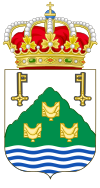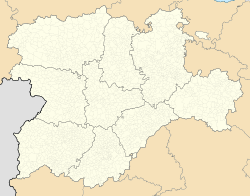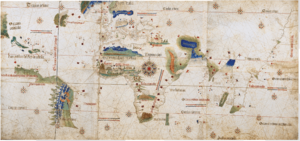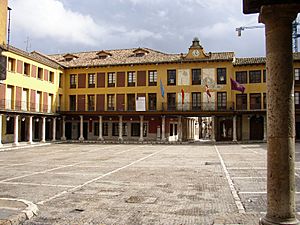Tordesillas facts for kids
Quick facts for kids
Tordesillas
|
|||
|---|---|---|---|
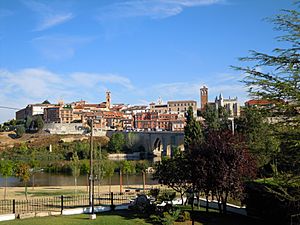
Southern Tordesillas in September 2012.
|
|||
|
|||
| Country | |||
| Autonomous community | |||
| Province | Valladolid | ||
| Comarca | Tierra del Vino | ||
| Area | |||
| • Total | 141.95 km2 (54.81 sq mi) | ||
| Elevation | 704 m (2,310 ft) | ||
| Population
(2018)
|
|||
| • Total | 8,825 | ||
| • Density | 62.170/km2 (161.019/sq mi) | ||
| Demonym(s) | Tordesillanos | ||
| Time zone | UTC+1 (CET) | ||
| • Summer (DST) | UTC+2 (CEST) | ||
| Postal code |
47100
|
||
Tordesillas is a town and municipality in central Spain. It is part of the province of Valladolid, in the region of Castile and León. The town is about 25 kilometers (15 miles) southwest of Valladolid, the provincial capital. It sits at an elevation of 704 meters (2,310 feet) above sea level. In 2021, about 8,760 people lived there.
Tordesillas is located on the Douro River. Even though the river flows through it, boats cannot travel on the Douro up to Tordesillas. The town is a major travel hub because of its important highway connections. It links to big cities like Madrid (182 km southeast) and Salamanca (96 km southwest). The provincial capital, Valladolid, is also connected by a four-lane highway.
The town's economy relies on services, especially tourism. Farming in the surrounding area is also important. Wheat has been a traditional crop for a long time. Tordesillas has many places to stay, including a special hotel called a Parador. There are also many restaurants, with one at the Parador having a high rating. North of the town, the Douro River creates a fertile valley. Farmers use modern irrigation systems there.
The town was once known for its "Toro de la Vega" festival. During this event, a bull was hunted by people on horseback and on foot. Animal rights groups worked hard to stop this practice.
Contents
A Look into Tordesillas' Past

Tordesillas began as a Roman settlement called Turris Sillae. It was built on a hill and served as a strong defense point during the Reconquista, a time when Christian kingdoms took back land from Muslim rule. In 1262, King Alfonso X gave the town its special rules.
The royal family and nobles started to favor Tordesillas. King Alfonso XI even built a palace there in 1325. In the 1400s, the town hosted several meetings of the Cortes, which were like early parliaments. Tordesillas often supported the monarchy during conflicts, including battles between King Henry IV and the nobles. It also supported the Catholic Monarchs against Joanna La Beltraneja in 1476.
The Treaty of Tordesillas
A very important event happened in Tordesillas in 1494. The Catholic Monarchs of Spain signed the Treaty of Tordesillas with Portugal. This treaty drew an imaginary line around the world. It divided new lands between Spain and Portugal for colonization. This agreement greatly affected how Portugal and Spain explored and settled the Americas.
The Comuneros Uprising
Even though Tordesillas usually supported the monarchy, it joined the Comuneros during the Castilian War of the Communities. This was a rebellion by citizens of Castile against the rule of Charles V. In 1519, the rebel leaders chose Charles's own mother, Queen Joanna I, as their ruler. She had been confined in the Santa Clara convent since 1509 by her father, Ferdinand II. The Comuneros came to Tordesillas to ask for her help.
However, in 1521, after almost a year of fighting, Charles V's supporters defeated the Comuneros at the Battle of Villalar. Royal troops then captured Tordesillas. This event in the 16th century marked the start of a long period where Tordesillas lost its power and wealth. Its location on important roads and highways has been key to its survival and growth since then.
Important Places to See
The Royal Convent of Santa Clara
The buildings of Santa Clara were first built as a palace by King Alfonso XI in 1344. His son, Peter the Cruel, had it decorated by skilled Mudéjar artists. These artists created beautiful works at Santa Clara, though on a smaller scale than their famous work in the Alcázar of Seville. Parts of Peter the Cruel's palace still remain, including the facade, a lovely small courtyard, a chapel, and the baths.
In 1363, Peter the Cruel gave Santa Clara to two of his daughters. They turned it into a convent, but it still served as a royal palace. In 1420, Prince Enrique of Aragón broke into the palace and captured King John II. The king managed to escape thanks to Álvaro de Luna. Queen Joanna of Castile, who spent much of her life confined in Tordesillas, was first buried at the Santa Clara convent. Later, her remains were moved to Granada. The convent still has a small clavichord, an old musical instrument, that is believed to have belonged to her.
Plaza Mayor and Churches
The Plaza Mayor is the historic and beautiful main square of Tordesillas. It is surrounded by buildings with colonnades and porticos from the 17th century, creating a lovely arcade.
Near the Plaza Mayor is the Church of Santa Maria. It was built between the 16th and 18th centuries and has a grand baroque sacristy. Other important churches in the town include San Juan, San Pedro, Santiago, and San Antolín.
The large 15th-century Church of San Antolín is very interesting. It has a museum of religious art collected from nearby churches. The church's spacious inside has one main nave. Its most impressive part is the rich Alderete Chapel. This chapel holds the 1550 alabaster tomb of Don Pedro de Alderete, a commander of the Order of Santiago.
Besides Santa Clara, Tordesillas also has two other historic convents: Convento de Carmelo and Convento de San Francisco.
Festivals and Celebrations
The main festivals in Tordesillas happen in September. The exact dates change each year.
Honoring Our Lady of the Rock
The celebrations honor 'La Virgen de la Peña' (Our Lady of the Rock). She is the patron saint of Tordesillas. Her small church is across the river. People go there for a romería (pilgrimage) in carts pulled by decorated horses.
The festivities start on September 8th, which is the Patron Saint's Day of Tordesillas, honoring 'Virgen de la Guía' (Our Guiding Lady).
The Saturday after September 8th is called "Sábado de Faroles" (Saturday of Lanterns). At night, there is a "Desfile de Faroles," a big parade. Different groups, called "peñas," carry large lanterns. Each side of the lantern is painted with pictures about Tordesillas and its festivals. The groups, with brass bands, parade through the streets. The group with the most beautiful lantern wins a prize. This unique celebration, which goes through the whole town, started from guards patrolling the old walls of Tordesillas.
The "El Toro de la Peña" Event
The "Virgen de la Peña" patron saint's day is celebrated on Sunday. The following Tuesday, there was a well-known local event called "Torneo del Toro de la Vega."
In 2016, the regional government banned this event. This happened because of growing worries about clashes between people who supported the event and those who were against it, often due to concerns for animal welfare. The event is now called "El Toro de la Peña."
Famous People from Tordesillas
- Gonzalo Queipo de Llano (1875–1951), a military leader.
- Moses ha-Kohen de Tordesillas (active in the 1370s), a Jewish scholar known for his debates.
See also
 In Spanish: Tordesillas para niños
In Spanish: Tordesillas para niños



